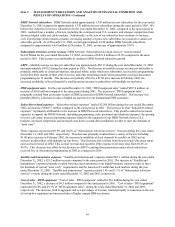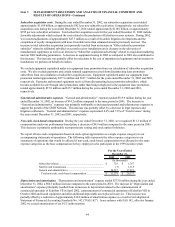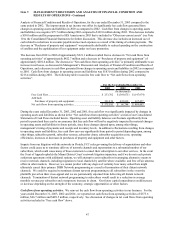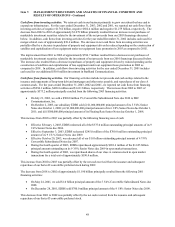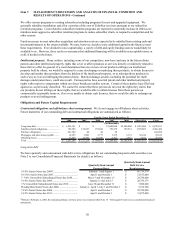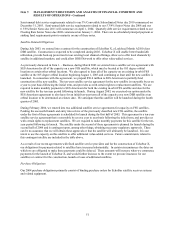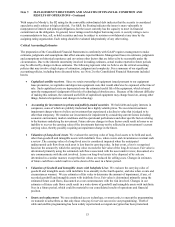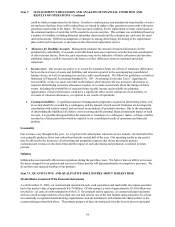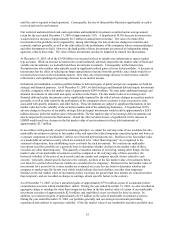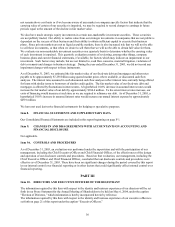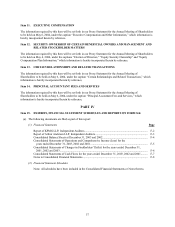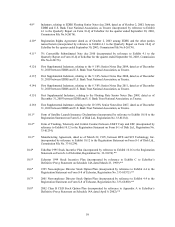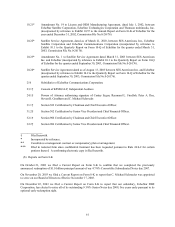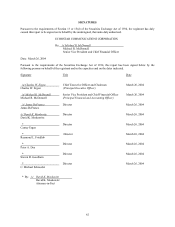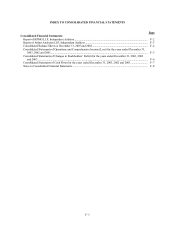Dish Network 2003 Annual Report Download - page 58
Download and view the complete annual report
Please find page 58 of the 2003 Dish Network annual report below. You can navigate through the pages in the report by either clicking on the pages listed below, or by using the keyword search tool below to find specific information within the annual report.Item 7. MANAGEMENT’S DISCUSSION AND ANALYSIS OF FINANCIAL CONDITION AND
RESULTS OF OPERATIONS - Continued
53
With respect to Moody’s, the B2 rating for the convertible subordinated debt indicates that the security is considered
speculative and is subject to high credit risk. For S&P, the B rating indicates the issuer is more vulnerable to
nonpayment of interest and principal obligations, but the issuer currently has the capacity to meet its financial
commitment on the obligation. In general, lower ratings result in higher borrowing costs. A security rating is not a
recommendation to buy, sell, or hold securities and may be subject to revision or withdrawal at any time by the
assigning rating organization. Each rating should be evaluated independently of any other rating.
Critical Accounting Estimates
The preparation of the Consolidated Financial Statements in conformity with GAAP requires management to make
estimates, judgments and assumptions that affect amounts reported therein. Management bases its estimates, judgments
and assumptions on historical experience and on various other factors that are believed to be reasonable under the
circumstances. Due to the inherent uncertainty involved in making estimates, actual results reported in future periods
may be affected by changes in those estimates. The following represent what we believe are the critical accounting
policies that may involve a high degree of estimation, judgment and complexity. For a summary of our significant
accounting policies, including those discussed below, see Note 2 to the Consolidated Financial Statements included
herein.
• Capitalized satellite receivers. Since we retain ownership of equipment issued pursuant to our equipment
lease promotion, we capitalize and depreciate equipment costs that would otherwise be expensed at the time of
sale. Such capitalized costs are depreciated over the estimated useful life of the equipment, which is based
upon the management’s judgment of the risk of technological obsolescence. Because of the inherent difficulty
of making this estimate, the estimated useful life of capitalized equipment may change based on, among other
things, historical experience and changes in technology.
• Accounting for investments in private and publicly-traded securities. We hold debt and equity interests in
companies, some of which are publicly traded and have highly volatile prices. We record an investment
impairment charge when we believe an investment has experienced a decline in value that is judged to be
other than temporary. We monitor our investments for impairment by considering current factors including
economic environment, market conditions and the operational performance and other specific factors relating
to the business underlying the investment. Future adverse changes in these factors could result in losses or an
inability to recover the carrying value of the investments that may not be reflected in an investment’s current
carrying value, thereby possibly requiring an impairment charge in the future.
• Valuation of Long-Lived Assets. We evaluate the carrying value of long-lived assets to be held and used,
other than goodwill and intangible assets with indefinite lives, when events and circumstances warrant such
a review. The carrying value of a long-lived asset is considered impaired when the anticipated
undiscounted cash flow from such asset is less than its carrying value. In that event, a loss is recognized
based on the amount by which the carrying value exceeds the fair value of the long-lived asset. Fair value is
determined primarily using the estimated cash flows associated with the asset under review, discounted at a
rate commensurate with the risk involved. Losses on long-lived assets to be disposed of by sale are
determined in a similar manner, except that fair values are reduced for selling costs. Changes in estimates
of future cash flows could result in a write-down of the asset in a future period.
• Valuation of Goodwill and Intangible Assets with Indefinite Lives. We evaluate the carrying value of
goodwill and intangible assets with indefinite lives annually in the fourth quarter, and also when events and
circumstances warrant. We use estimates of fair value to determine the amount of impairment, if any, of
recorded goodwill and intangible assets with indefinite lives. Fair value is determined primarily using the
estimated future cash flows, discounted at a rate commensurate with the risk involved. Changes in our
estimates of future cash flows could result in a write-down of goodwill and intangible assets with indefinite
lives in a future period, which could be material to our consolidated results of operations and financial
position.
• Smart card replacement. We use conditional access technology, or smart cards, to encrypt the programming
we transmit to subscribers so that only those who pay for service can receive our programming. Theft of
cable and satellite programming has been widely reported and our signal encryption has been pirated and


